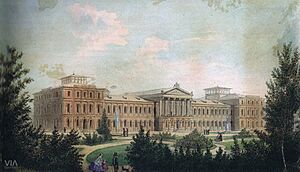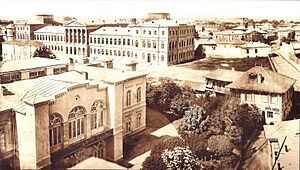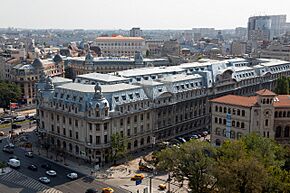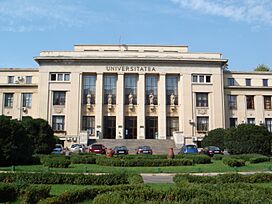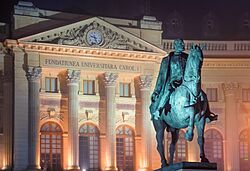University of Bucharest facts for kids
|
Universitatea din București
|
|
 |
|
| Latin: Universitas Studiorum Bucurestiensis | |
|
Other names
|
UB, UniBuc |
|---|---|
| Motto | Virtute et Sapientia (Latin) |
|
Motto in English
|
Virtue and Wisdom |
| Type | Public |
| Established | 1694 – Princely Academy of Bucharest 1821 – Saint Sava College 4 July 1864 |
|
Academic affiliations
|
IAU, UNICA, EUA, CIVIS |
| Endowment | RON 1.14 billion (US$274.76 million) (2018) |
| Budget | RON 364.7 million (US$87.67 million) (2018) |
| Rector | Marian Preda |
|
Academic staff
|
1,300 (2022) |
| Students | 32,576 (2022–2023) |
| Undergraduates | 22,428 (2022–2023) |
| Postgraduates | 8,911 (2022–2023) |
| Location |
,
Romania
|
| Campus | Urban |
| Colors | navy blue |
The University of Bucharest (often called UB or UniBuc) is a big public university in Bucharest, Romania. It's a place where students go to learn and do advanced research. It was officially started on July 4, 1864, by Prince Alexandru Ioan Cuza. He turned an older school, the Princely Academy, into the university we know today. This makes it one of Romania's oldest universities. It's also part of a special group of top Romanian universities called the Universitaria Consortium.
The University of Bucharest offers many different study programs. You can study in Romanian or English. The Ministry of Education in Romania sees it as an "advanced research and education university." This means it's a leading place for learning and discovering new things.
Contents
History of the University
The University of Bucharest was officially created on July 4, 1864. This happened thanks to a special order from Prince Alexandru Ioan Cuza. Since then, it has become a very important place for learning and a key part of Romanian society.
The university has a long and interesting history, going back to 1694. That year, Constantin Brâncoveanu, who was the ruler of Wallachia, started the Princely Academy. At first, lessons were taught in Greek. Later, in 1776, Alexander Ypsilantis changed the school's plan. He added courses in French, Italian, and Latin. After 1821, the Saint Sava College continued the work of the Princely Academy.
In 1857, the first stone was laid for the main University Palace building in Bucharest. In 1859, the Faculty of Law was created. Then, on July 4, 1864, Prince Alexandru Ioan Cuza brought together the Faculties of Law, Sciences, and Letters to form the University of Bucharest. Over the years, more faculties were added, like Medicine in 1869 and Theology in 1884.
In 1956, students from this university tried to organize a peaceful protest against the government at the time. However, they were stopped. (You can learn more about this in the Bucharest student movement of 1956 article). For a short time in the 1950s and early 1960s, the university was called the "C. I. Parhon University."
During World War II, in 1944, parts of the main university building were damaged by bombs. They were rebuilt between 1969 and 1971. The area around the old university building, known as University Square, was a central spot for many protests during the Romanian Revolution in 1989. In 1990, it was also a place for protests against the former communist government.
In 1996, Emil Constantinescu, who was the head of the University of Bucharest at the time, was elected President of Romania.
How the University is Organized
Faculties: Areas of Study
The University of Bucharest has 19 faculties. These are like different schools within the university, each focusing on a specific area of study. They cover many subjects, including:
- Business and Administration
- Biology
- Chemistry
- Law
- Philosophy
- Physics
- Geography
- Geology and Geophysics
- History
- Journalism and Communication Studies
- Foreign Languages and Literatures
- Letters (like Romanian language and literature)
- Mathematics and Computer Science
- Psychology and Education Sciences
- Sociology and Social Work
- Political Science
- Orthodox Theology
- Roman Catholic Theology
- Baptist Theology
Academic and Research Units
The university also has special departments that focus on different areas of learning and research. These include:
- A Technology Department
- A Distance Learning Department (for online studies)
- A UNESCO Department for understanding different cultures and religions
- A Department of Education Pedagogy (about teaching methods)
- A French-speaking Doctoral School for Social Sciences
The university also has its own publishing house, where they print books and research papers. There are many research groups and institutes, like the Institute for Political Research and the Center for Nuclear Research. The university offers master's and doctorate programs for advanced studies. It also works with over 50 universities in 40 different countries. This allows students to take part in European programs like ERASMUS, which lets them study abroad.
University Buildings (Campus)
The University of Bucharest doesn't have just one big campus like some universities. Instead, its buildings are spread out across the city of Bucharest. Its two main buildings are:
- The Old Building: This is in University Square, right in the city center. It houses faculties like Mathematics and Computer Science, History, Chemistry, Geography, and Letters.
- The Palace of the Faculty of Law: This building is near the Opera House and is home to the Faculty of Law.
Other faculties have their own buildings and research places in different parts of the city. For example:
- The Faculty of Physics is located in the town of Măgurele, about 16 kilometers (10 miles) south of Bucharest.
- The Faculty of Biology and the Faculty of Philosophy are on Splaiul Independenței.
- The Faculty of Psychology is on Șoseaua Panduri.
- The Faculty of Political Science is on Sfântu Ștefan Street.
- The Faculty of Orthodox Theology is near Unirii Square.
- The Faculty of Roman Catholic Theology is on General Berthelot Street.
- The Faculty of Baptist Theology is on Berzei Street.
University Rankings
| University rankings | |
|---|---|
| Global – Overall | |
| QS World | 851–900 (2024) |
| THE World | 1001–1200 (2024) |
| USNWR Global | =1066 (2023) |
University rankings show how a university compares to others around the world. In 2012, the University of Bucharest was ranked among the top 601-701 universities globally by the QS World University Rankings.
The University of Bucharest has received special awards for its excellent work. It was given the National Academic Excellence Diploma in 2000 and the National Academic Excellence Medal in 2004. All the degrees and diplomas from this university are recognized internationally, which means they are accepted in other countries.
Working with Other Organizations (Affiliations)
The University of Bucharest is part of many international groups and partnerships. This means it works together with other universities and organizations around the world. Some of these include:
- The Association of Universities in European Capitals (UNICA)
- The Network of South-East European Universities
- The European University Association (EUA)
- Agence Universitaire de la Francophonie (AUF)
- Black Sea Universities Network (BSUN)
- Academic Cooperation Association (ACA)
- European Inter-University Centre for Human Rights and Democratization (EIUC)
- Eurasian Universities Union (EURAS)
- SEE GRID - South-East Europe GRID - 2005
- Central European Exchange Program for University Studies (CEEPUS)
- ERASMUS NETWORK EUE-NET
- Educational Structure in Europe, Phase IV (TUNING)
- European Physics Education Network (EUPEN)
- Stakeholders Tune European Physics Studies (STEPS)
The university has about 225 agreements with European partner universities through the ERASMUS program. This allows many students to study abroad for a period of time.
People from the University
Past and Present Teachers (Faculty)
Many talented people have taught at the University of Bucharest. Some famous names include:
- Ion Barbu – a mathematician and poet
- George Călinescu – a writer and literary critic
- Mircea Cărtărescu – a well-known writer
- Emil Constantinescu – who later became the 3rd President of Romania
- Neagu Djuvara – a historian
- Eugène Ionesco – a famous Romanian-French playwright
- Nicolae Iorga – a historian, literary critic, and politician
- Solomon Marcus – a mathematician
- Dimitrie Pompeiu – a mathematician
- Simion Stoilow – a mathematician
- Nicolae Titulescu – a politician
Former Students (Alumni)
Many successful people have studied at the University of Bucharest. These former students are called alumni. Some notable alumni include:
- Albert-László Barabási – a physicist
- Mircea Cărtărescu – a postmodern writer
- Zoia Ceaușescu – a mathematician
- Emil Cioran – an essayist and philosopher
- Daniel Dines – a billionaire entrepreneur
- Mircea Eliade – a historian of religion and writer
- Nicholas Georgescu-Roegen – an economist
- George Emil Palade – a cell biologist who won the Nobel Prize in 1974
- Nicolae Paulescu – a physiologist who discovered insulin
- Andrei Pleșu – a philosopher and politician
- Victor Ponta – a former Prime Minister of Romania
- Mihail Sadoveanu – a writer
- George Simion – a politician and activist
- Șerban Țițeica – a physicist
Rectors: Heads of the University
The rector is the main leader of the university. Here is a list of the rectors of the University of Bucharest:
- Gheorghe Costaforu (1864–1871)
- Vasile Boerescu (1871)
- Ioan Zalomit (1871–1885)
- Alexandru Orăscu (1885–1892)
- Titu Maiorescu (1892–1897)
- Grigoriu Ștefănescu (1897–1898)
- Constantin Dimitrescu-Iași (1898–1911)
- Ermil Pangrati (1911–1912)
- Ioan Bogdan (1912)
- Thoma Ionescu (1912–1915)
- Ioan Athanasiu (1915–1920)
- Mihail Vlădescu (1920–1923)
- Ermil Pangrati (1923–1929)
- Nicolae Iorga (1929–1932)
- Nicolae Gheorghiu (1932–1936)
- Constantin C. Stoicescu (1936–1940)
- Petre P. Panaitescu (1940–1941)
- Alexandru Otetelișanu (1941)
- Horia Hulubei (1941–1944)
- Daniel Danielopolu (1944)
- Simion Stoilow (1944–1946)
- Alexandru Rosetti (1946–1949)
- Ilie G. Murgulescu (1949–1950)
- Constantin Balmuș (1950–1952)
- Avram Bunaciu (1952–1954)
- Nicolae Sălăgeanu (1954–1957)
- Iorgu Iordan (1957–1958)
- Jean Livescu (1959–1963)
- Gheorghe Mihoc (1963–1968)
- Jean Livescu (1968–1972)
- George Ciucu (1972–1981)
- Ioan-Ioviț Popescu (1981–1988)
- Ion Dodu Bălan (1989)
- Nicolaie D. Cristescu (1990–1992)
- Emil Constantinescu (1992–1996)
- Ioan Mihăilescu (1996–2005)
- Ioan Pânzaru (2005–2012)
- Mircea Dumitru (2012–2019)
- Marian Preda (2019–Present)
See also
 In Spanish: Universidad de Bucarest para niños
In Spanish: Universidad de Bucarest para niños
- List of modern universities in Europe (1801–1945)


